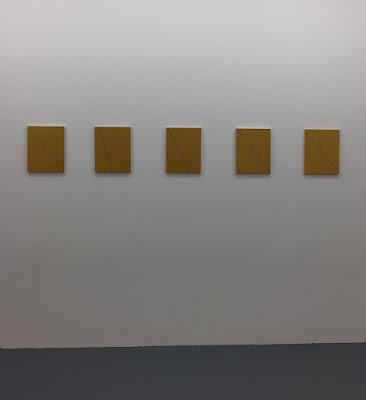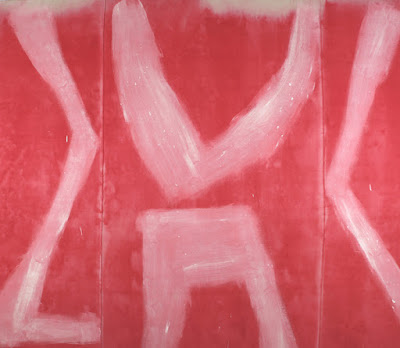Neshama, 2015, acrylic & powdered pigment on canvas, 198 x 228 cm.
Who's Afraid of Colour
 |
| Nonggirrnga Marawilli, 'Lightning in the rock', 2015. |
 |
| Raelene Kerinauia, Kayimwagakimi Jilamara, 2011. |
 |
| Muntararr Rosie Williams, Yikartu Bumba, Yimiri, 2009. |
 |
| Tali Tali Pompey, Para, 2009. |
 |
| Treahna Hamm, Wollithica Woka (Tribal homelands around Echuca/Moamza), 2013. |
 |
| Emily Kam Kngwarray, Awely x 6, 1993. |
NGV Collection
 |
| Tony Tuckson and Elwyn Lynn paintings, Norma Redpath sculpture. |
 |
| Hugh Ramsay, 'Portrait of an artist standing before easel' 1901-2. |
| Clarice Beckett, 'Beach Road after the rain (Street scene)' c1927. |
 |
| Tom Roberts, 'Harpers Weekly, c1889. |
Moments of the ordinary. A few favorites from the Ian Potter Centre for Australian Art.
Ravenswood
W. B. McInnes
I decided to research a nearby house I've long been
fascinated by. I found the property has no real estate sales history on line. On
Google I found a footnote in a book by Anne Sommers, 'The Lost Mother: A
Story of Art and Love', 2010. The book itself is a detective story into a portrait of
Anne's mother by Constance Stokes. The house I have discovered was the home of
William Beckwith McInnes, 1889-1939, and his artist wife, Violet Muriel
Musgrave. McInnes was a portrait painter who won the Archibald seven times,
exhibited at the London Royal Academy and succeeded Frederick McCubbin as head
of drawing at the National Gallery School. Later McInnes became head of
painting at the school after Bernard Hall's death. He was also a landscape
painter who frequently painted his local area of Lucerne in Alphington. He
lived with Violet here from 1915. The photo is a real estate shot and does the
house no justice. It's a magical sloping garden with impeccable detail and the
house is set to the back of the property near the Yarra River.
Anne Summers PhD AO, is a leading feminist writer and
journalist who has a connection with the following owners of the house who were
Russian art collectors of Constance Stokes.
 |
| A real estate photo of the house |
 |
| An Archibald winning painting by McInnes 1923 |
 |
| A Lucerne 'urban' landscape with Kew Asylum in the background |
Editions
Editions
Curated by Keith Lawrence, 'Editions' at Tacit Contemporary Art, Melbourne, is an annual exhibition now in its fifth year. The show celebrates the work of over forty Victorian based printmakers. The exhibition encompasses all the gallery spaces at Tacit and covers a broad spectrum of trends in printmaking. It's a diverse exhibition sure to please as works range from intimate figurative studies to large scale abstract works. The approaches to printmaking represent current technologies in silk screen, lino cut, etching, monoprints and colographs. The surfaces printed upon often stretch the traditions of printmaking including various papers, materials and even linen. The framing was also experimental with many works forgoing the traditional mount and glass frames.
8-26 February, 2017
312 Johnston St, Abbotsford
 |
| T J Bateson, Soft White Iteration, linocut, 77 x 233 cm. |
 |
Louise Bylton, Flayed Anew I, II, III, silkscreen on linen, 21 x 31 cm.
|
 |
| Malini Maunsell, monoprints, size varies. |
 |
| Diana Orinda Burns, Line Formations #2, collagraph, 76 x 116 cm |
 |
| Jodi Heffernan, Coastal Edge, silk screen with printed Tulle 30 x 30 cm (image). |
 |
| Standing room only at the Editions opening last night at Tacit |
Curated by Keith Lawrence, 'Editions' at Tacit Contemporary Art, Melbourne, is an annual exhibition now in its fifth year. The show celebrates the work of over forty Victorian based printmakers. The exhibition encompasses all the gallery spaces at Tacit and covers a broad spectrum of trends in printmaking. It's a diverse exhibition sure to please as works range from intimate figurative studies to large scale abstract works. The approaches to printmaking represent current technologies in silk screen, lino cut, etching, monoprints and colographs. The surfaces printed upon often stretch the traditions of printmaking including various papers, materials and even linen. The framing was also experimental with many works forgoing the traditional mount and glass frames.
Roadie Punk Paintings
 |
| Billy Gruner, New Work for a Failed System, no’s 8-12, 2017, Gold Gesso and Acrylic on Wood, 28 x 35 cm x 5 pieces. |
 |
Kyle Jenkins, Celare Monochrome Series #9-13, 2017,
each work acrylic on canvas, 45 x 45 cm.
|
Roadie Punk Paintings
February 1 – 18
Five Walls Projects, Footscray
Billy Gruner and Kyle Jenkins have worked
together since their PhD days and were invited to launch the new project space
at Five Walls, a Melbourne gallery committed to reductive art. Symbolically the
very first exhibition at Five Walls was also by Jenkins and Gruner.
Gruner refers to his own works and that of his long-time
collaborator Jenkins, as Post-Formalist in this 21st Century. Both artists
acknowledge a legacy to the Punk and Conceptual Art movements of the 1970s in
the exhibition notes. The text goes on to state the seventies was a time of
great social unrest and ‘upheaval’ against an established austere conservativism.
The London Garbage Strikes under Thatcherism and the later Brixton Riots being
two examples.
The materials, ‘sacred’ colour, and use of an articulated architectural
line by Gruner in ‘New Work for a Failed System’ reference Gothic icon painting.
Celare is Latin for ‘hide’ or ‘to conceal’
and Jenkins', Romanesque ‘Celare Monochrome Series’ refutes definition. Together
the works and gallery text suggest a discontent with the current seemingly
return to right-wing conservatism. A darkness, perhaps a medieval one as Gruner
alludes to, is falling as century old traditions of methods and research post-Renaissance
are challenged including the authenticity of science and journalism. ‘The
System is Failing’ not only for global culture but for contemporary discourse in
abstraction post-20th Century.
The references to pre-Renaissance painting are fitting
methodologies for both artists. Historically, many of the Modernist
abstractionists including Rothko, researched medieval art as a pathway to Abstraction.
Individually Gruner and Jenkins have shown extensively
throughout the world and founded artist project spaces including SNO (Sydney
Non Objective) Art. They have also curated and locally collaborated with like minded artists in Europe producing touring group shows of Australian art including ‘Australia
– Contemporary Non Objective Art’ held at GKG in Bonn, 2008.
Thanks to Billy Gruner for editing assistance.
William Ferguson
| Desert Night Memory, acrylic on paper, 40 x 57 cm. |
| Tribal Warrior, acrylic on board, 60 x 52 cm. |
 |
| William Ferguson at work |
William Ferguson b.1933 'My Dream Time and Spirit of Place' solo exhibition at Quadrant Gallery, Melbourne to July 23. Visit the full exhibition catalogue here. William has always stayed true to his vision of abstraction and has had a long and successful career exhibiting nationally and internationally. He was also a very influential and inspirational senior lecturer at RMIT University.
Stedelijk Museum
The Stedelijk Museum, Amsterdam, had a superb collection of contemporary art. A large proportion of it is world class abstraction. Below are some of the great works.
 |
| Piet Mondrian, Windmolen, c 1917. |
 |
| Kazimir Malevich paintings from 1917-21. |
 |
| Sonia Delaunay, Curtain Material, 1951. |
 |
| Willem de Kooning, North Atlantic Light, 1977, |
 |
| detail: Willem de Kooning, Two Figures in a Landscape, 1967. |
 |
| detail: Agnes Martin, Untitled No. 8, 1981. |
 |
| Richard Tuttle, Blue White, 1968. |
 |
| Dan Flavin, "monument" for V. Tatlin, 1969. |
 |
| Gordon Matta-Clark, The Land of Milk and Honey, 1969. |
 |
| Donald Judd. |
 |
| Ellsworth Kelly, White Curve 1, 1972. |
Subscribe to:
Posts (Atom)


